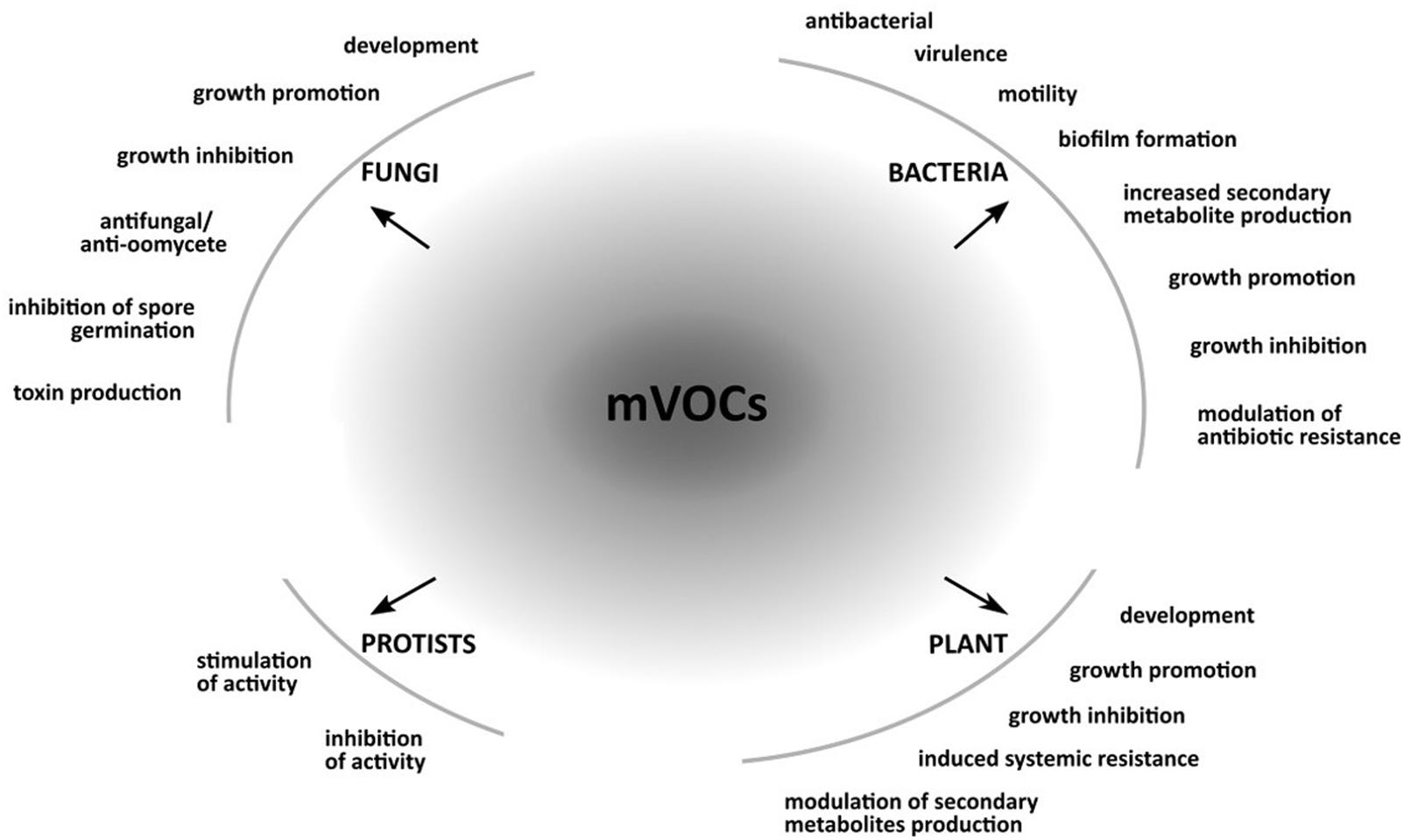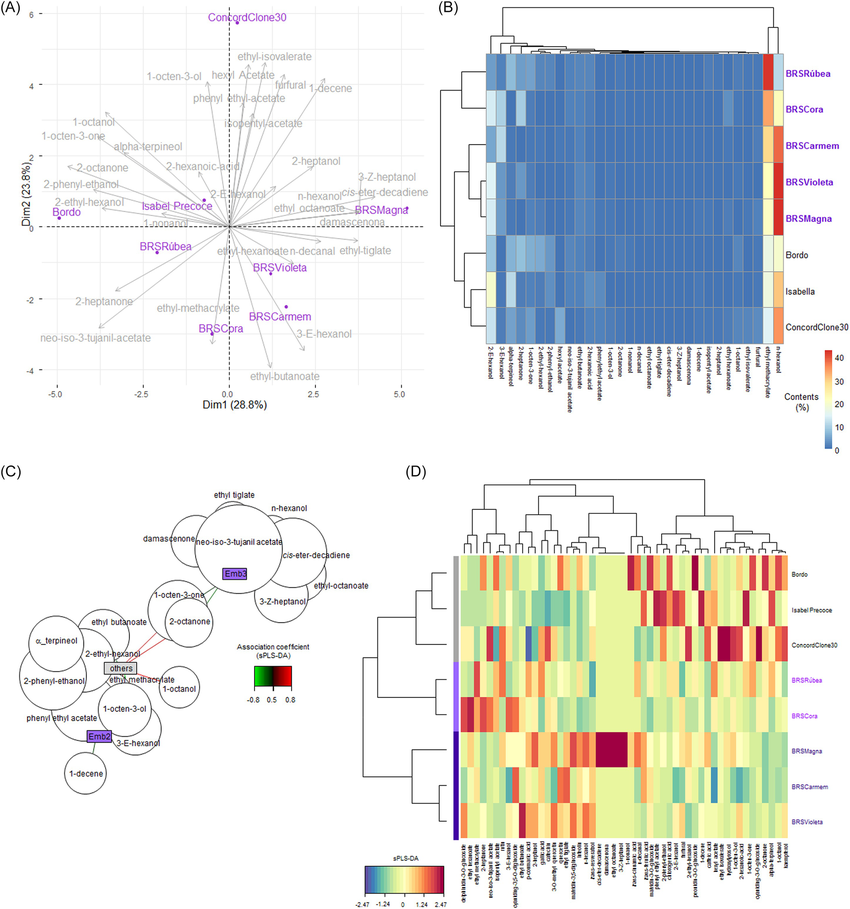Volatile Metabolite Analysis Service
Volatile Metabolite Analysis Service is a non-targeted metabolomics service based on gas chromatography-mass spectrometry (GC-MS) technology. It is designed to comprehensively and systematically detect and quantify low-molecular-weight metabolites released in gaseous form from biological samples.

Schulz-Bohm K. et al. Front. Microbiol. 2017.
Figure 1. Responses in bacteria, fungi, protists and plants caused by microbial volatile organic compounds (mVOCs).
Volatile metabolites are low-molecular-weight compounds that can be released in gaseous form under ambient temperature and pressure. These include alcohols, ketones, esters, organic acids, terpenes, and more. They are widely present in animals, plants, microbes, and environmental systems. Due to their low molecular weight, high vapor pressure, and strong volatility, volatile metabolites play crucial roles in physiological metabolism, signal transduction, intra-/interspecies communication, and ecological adaptation.
Volatile metabolite analysis is a highly sensitive technique capable of capturing and quantifying these complex chemical "signals" in a non-destructive or minimally invasive manner. It enables researchers to construct comprehensive "odor metabolite profiles" and uncover the biochemical rules behind scent-related phenomena. This technology has been extensively applied in various research fields, including plant volatile metabolism, microbial volatile compound analysis, metabolic fingerprinting, food quality control, and environmental stress response studies. It serves as a powerful tool for understanding functional states and metabolic dynamics in biological systems.
Based on a high-sensitivity gas chromatography-mass spectrometry (GC-MS) platform, MtoZ Biolabs’ Volatile Metabolite Analysis Service offers comprehensive detection, identification, and quantification of volatile small-molecule metabolites from complex biological samples. This service can construct a systematic volatile metabolite map to help understand metabolic regulation mechanisms and functional dynamics from a systemic level. It is suitable for a variety of scientific research directions such as basic research, agricultural ecology, food science and natural product development.
Analysis Workflow
Volatile Metabolite Analysis Service by MtoZ Biolabs follows a rigorous and systematic workflow, ensuring high reproducibility and data reliability from sample preparation to bioinformatics analysis:
1. Sample Preprocessing
Customized protocols are developed based on sample type, focusing on enriching volatile metabolites and effectively removing background contaminants.
2. Automated Sample Handling
Automated workstations and SPME (solid-phase microextraction) are used to standardize the extraction and enrichment of volatiles across all samples.
3. Gas Chromatography (GC) Separation
High-quality columns and optimized chromatographic conditions are used to effectively separate complex mixtures of volatile compounds. The analysis is performed using a PAL autosampler to ensure batch-to-batch consistency.
4. Mass Spectrometry (MS) Detection
Data acquisition is conducted in splitless mode using optimized carrier gas flow rates and temperature programs to achieve strong and stable signal responses for all metabolite classes.
5. Data Processing and Metabolite Identification
Raw MS data is processed using professional software for deconvolution and peak detection. Compound identification is performed using the NIST spectral database.
6. Bioinformatics Analysis
Includes differential metabolite screening, principal component analysis (PCA), KEGG pathway enrichment, and more.
Service Advantages
1. Advanced Analysis Platform: MtoZ Biolabs established an advanced Volatile Metabolite Analysis Service platform, guaranteeing reliable, fast, and highly accurate analysis service.
2. One-Time-Charge: Our pricing is transparent, no hidden fees or additional costs.
3. High-Data-Quality: Deep data coverage with strict data quality control. AI-powered bioinformatics platform integrates all Volatile Metabolite Analysis Service data, providing clients with a comprehensive data report.
Applications
Volatile Metabolite Analysis Service is applicable across multiple life science domains, including:
Plant Metabolism Research
Investigating the relationship between volatiles and plant growth, defense, or signaling.
Microbial Ecology
Profiling microbial volatiles for understanding interspecies communication and metabolic dynamics.
Food Science and Flavor Research
Characterizing volatile changes during fermentation or ingredient processing.
Environmental Response Studies
Monitoring volatile metabolic changes in response to stressors like drought, salinity, or pollutants.
Biomarker Discovery
Identifying specific metabolic fingerprints linked to physiological or pathological states.
FAQ
Q. Do you Support Custom Libraries, RI Calibration, or Commercial Databases Like Wiley?
Yes. MtoZ Biolabs primarily uses the NIST Mass Spectral Library, which contains over 160,000 reference compounds, covering a wide range of volatiles (e.g., alcohols, ketones, esters, terpenes, aromatics). For higher-confidence annotations, we also support RI (Retention Index) calibration, MS quality scoring, and manual verification. Custom libraries (e.g., plant-specific or microbiota-specific) and commercial databases like Wiley and FFNSC can be integrated upon request.
Q. Do you Include QC Samples to Monitor Inter-Batch Consistency? What is the QC Frequency?
Yes. We incorporate QC samples (Quality Control) throughout the workflow to monitor instrument stability and batch effects. Typically, one QC sample is included for every 5-10 experimental samples. QC evaluations include PCA clustering, RSD statistics, and Total Ion Chromatogram (TIC) overlays to ensure reproducibility and stability. All projects are accompanied by a QC report detailing metrics such as signal distribution and clustering performance.
Deliverables
1. Comprehensive Experimental Details
2. Materials, Instruments, and Methods
3. Total Ion Chromatogram & Quality Control Assessment (project-dependent)
4. Data Analysis, Preprocessing, and Estimation (project-dependent)
5. Bioinformatics Analysis
6. Raw Data Files
Case Study
In this study, GC-MS was employed to analyze the volatile metabolite profiles of juices from various grape cultivars. The results revealed that the genetic background of the cultivars significantly influenced the volatile compound composition. For instance, the cultivar “BRS Magna” showed a broader and more complex array of 29 identified volatile compounds, underscoring the role of genotype in determining flavor profile and metabolic fingerprint. These findings help elucidate the biochemical basis of juice quality and functional diversity across grape varieties.

Gomez HAG. J Sci Food Agr. 2024.
Figure 2. Profile of volatile metabolites in the juices.
How to order?







